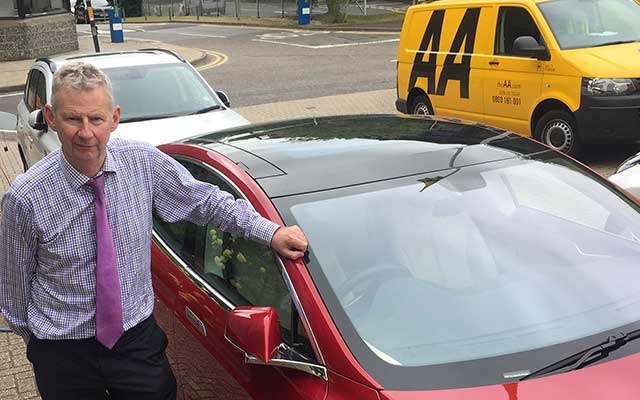7 June 2023
There has been more than a 70% drop in the proportion of electric vehicles running out of charge over the last few years, according to the AA, the UK’s largest motoring organisation.
This comes at a time with various reports warning that the number of on-street chargers is not keeping up with the number of EVs on the roads.
The number of ‘out of charge’ EV breakdowns was running at 8% of all EV breakdowns four years ago and dropped to 4% of breakdowns last year. This year the figures have dropped further and are running at just 2.1% of EV breakdowns.
This year to date the AA has dealt with 39,109 EV Breakdowns which is equal to just 2.86% of total breakdown workload including petrol and diesel vehicles.
In May this year 2.83% of our breakdowns were EV, which equates to 7,428 individual callouts.
EVs out of charge were less than 2% for the first time in May, at 1.8% of our total EV workload, which equated to 135 breakdowns.
The AA president, Edmund King OBE, will address the Annual EV Infrastructure Summit on this issue in London today (7).
He will argue that the proportion of EVs running out of charge has dropped dramatically due to:
- Most new EVs now have longer ranges and the majority can do at least 250 miles and some top of the range models almost 500 miles.
- The public charging network is more reliable and constantly growing whilst there has also been growth in the provision of domestic and work-place chargers.
- Drivers are better informed and receive more help on when, where, and how to charge.
According to Zapmap, at the end of April 2023, there were 42,566 electric vehicle charging points in the UK, across 24,909 charging locations. This represents a 37% increase in the total number of charging devices since April 2022.
In addition, King will point to the increase in domestic and work-place chargers as another reason for the dramatic drop in ‘out of charge’ EVs in the AA’s breakdown data.
The Office for Zero Emission Vehicles (OZEV) provides grants to support the use of electric vehicles, including the installation of charging devices in the UK which is also helping to provide different charging options.

Domestic Charging Devices
As of 1 April 2023:
- The newest OZEV funded grant scheme, the EVCG, has funded the installation of 2,347 sockets since the scheme was launched in April 2022
- Previous OZEV funded grant schemes (EVHS and DRS) have delivered 380,108 domestic charging devices since 2013
- The EVHS has funded the installation of 339,775 domestic charging devices.
Workplace Charging Devices
As of 1 April 2023:
- The WCS has funded the installation of 42,104 sockets in workplace carparks since the scheme started in 2016
- The WCS funded 13,396 sockets installations since 1 April 2022, an increase of almost 3% compared to the previous 12-month period
As of 1 April 2023:
- The ORCS has funded 4,235 public charging devices which have been installed across local authorities in the UK since the scheme started in 2017
- 331 on-street charging devices were installed after being claimed for by the local authorities in the previous 3 months
- Funding has also been awarded for 13,986 additional ORCS charging devices to be installed in the future
“Our data on ‘out of charge’ EVs clearly shows ‘charging anxiety’ does not match the reality.”
King will also give more details on breakdowns and the fact that the AA fixes more than eight out of ten EVs at the roadside which is similar to petrol / diesel vehicles fix-rates.
In many ‘out of charge’ cases the vehicle is not actually out of charge, but the AA has been called out as the EV is low on charge. In Norway, which has a much higher concentration of EVs than the UK, the percentage of out of charges is just 1%.
Running out of petrol / diesel is also consistently 1% of the AA’s workload, and the organisation believes that EVs will end up at this same run rate in time.
The top one third of breakdowns for EVs are the same faults as with petrol or diesel cars – 12v battery problems and tyres.
Other EV faults are quite different and cover things such as charging equipment, warning lights, battery monitoring systems or key transponders.
Edmund King said: “Our data on ‘out of charge’ EVs clearly shows ‘charging anxiety’ does not match the reality. The 70% drop in out of charge breakdowns is a clear sign that range, infrastructure, and education are improving. Of course, we need a concerted effort to continue the roll-out of reliable and accessible charging to fill in the gaps and to address the problem for those that don’t have off-street parking to charge.
“The vast majority of EV owners do most of their charging at home or on-street close to home and then use the charging network to top up whilst on those more infrequent longer journeys. With a little planning, stopping off to charge up can be convenient and enhance road safety as taking a break is recommended every two hours or so.
“There has never been a better time to buy a used EV as many prices have dropped dramatically in the last six months. Once the car has been purchased the running and servicing costs tend to be much lower.
“The economic and environmental benefits of running an EV are clear but it appears that some drivers are put off by ‘charging anxiety’ which does not reflect the reality for most drivers or indeed the AA.”
City & Financial Global is delighted to announce the next edition of the Annual EV Infrastructure Summit, which will be held at KPMG, Canary Wharf, London on the 7 June 2023.
Electric vehicle charging device grant scheme statistics: April 2023 - GOV.UK (www.gov.uk)
